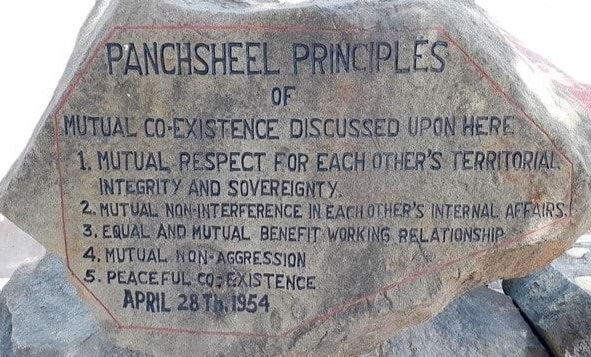Reference
China has organized a commemorative conference to mark the 70th anniversary of the establishment of the five principles of peaceful coexistence, which India named Panchasheel. In this conference, China has said that it will strongly advance this concept of its foreign policy.

What is the Panchasheel principle
- The concept of the “Five Principles of Peaceful Coexistence” of China's foreign policy was first articulated in an agreement with India in 1954.
- This agreement was signed between the first Prime Minister of India, Jawaharlal Nehru and the former Prime Minister of China, Chou Inlei.
- The Panchasheel Agreement, formally known as the “Agreement on Trade and Intercourse with the Tibet Region”, was signed on April 29, 1954 by Indian Ambassador to China N. Raghavan and Chinese Foreign Minister Zhang Han-fu.
- It was decided in the agreement that both countries will not take any aggressive action against each other.
- The word Panchasheel was selected from Buddhist records by Pandit Jawaharlal Nehru.
- In Buddhist scriptures, the abstinence from murder, theft, adultery, lying and drinking alcohol is called Panchasheel.
The major principle
- The preamble of the Panchsheel Agreement sets out five guiding principles:
- Respecting each other's territorial integrity and sovereignty.
- Not to take aggressive action against each other.
- Not to interfere in each other's internal matters.
- To follow the policy of equality and mutual benefit.
- Believe in the policy of peaceful co-existence.
Key provisions of the agreement
- Trade Relations: To enhance trade and cooperation between the two countries, establishing trade centres of each country in each other's major cities and creating a framework for trade.
- Cultural Relations: Important religious pilgrimages, facilities for pilgrims and acceptable routes available to them were also listed.
- Recognition of Tibet as Chinese territory: For the first time, India recognised Tibet as part of China's Tibet region.
- India gave up its rights with regard to Tibet under the Anglo-Tibetan Treaty of 1904 following this agreement.
Influence of the Panchasheel principles
- The Five Principles of Peaceful Coexistence were adopted as guiding principles at the Afro-Asian Bandung Conference in 1955.
- The Bandung Conference of April 1955 was attended by 29 countries from Asia and Africa and signed a 10-point declaration.
- The Bandung Conference served as a forerunner to the Non-Aligned Movement (NAM).
- The Non-Aligned Movement is a group of nations that voluntarily decided not to align themselves with either of the two global power blocs led by the United States and the Soviet Union.
- NAM was established on July 19, 1956 with the signing of the “Brioni Declaration” by Indian Prime Minister Jawaharlal Nehru, President of Yugoslavia Josif Broz Tito and President of Egypt Gamal Abdel Nasser.
- The Brioni Islands are in the northern Adriatic Sea, and are now part of Croatia.
- The Panchasheel was adopted as the "fundamental principle" of the group at the first Non-Aligned Summit, held in Belgrade in 1961.
- These principles were later adopted by the United Nations General Assembly in 1957, spearheaded by India, Yugoslavia and Sweden.
China's hegemonic policy
- China itself has been violating its five principles of co-existence by adopting a hegemonic approach towards other neighbours including India.
- The first three principles were violated by China in less than a decade.
- Mutual respect for territorial integrity and sovereignty was denied and China continued to occupy large parts of Indian territory.
- With the help of Pakistan, China also captured a large part of Aksai Chin.
- China’s Belt and Road Initiative (2013) and the China Pakistan Economic Corridor (CPEC) project are evidence of its aggressive intent to violate India’s status quo and territorial integrity.
- At present, as the geopolitical situation is more serious and dangerous, China's geographical and trade aggression is continuing at a rapid pace.
- China aims to achieve pole status to lead a group of like-minded countries in the upcoming Cold War 2.0 scenario.
- China, well versed in the art of grey zone warfare, continues to openly present the Five Principles as the core of its foreign policy in its disputes.
Conclusion
- The Panchsheel Agreement was a well-thought-out step towards improving economic and political relations between India and China, but China took wrong advantage of it and betrayed India.
- India, which still believes in the Panchasheel principles and advances a new universal outlook through its principle of Vasudhaiva Kutumbakam.
- India is ensuring access to all the countries of the world through dialogue and diplomacy for global welfare, peace and stability and is moving towards leading the world.
